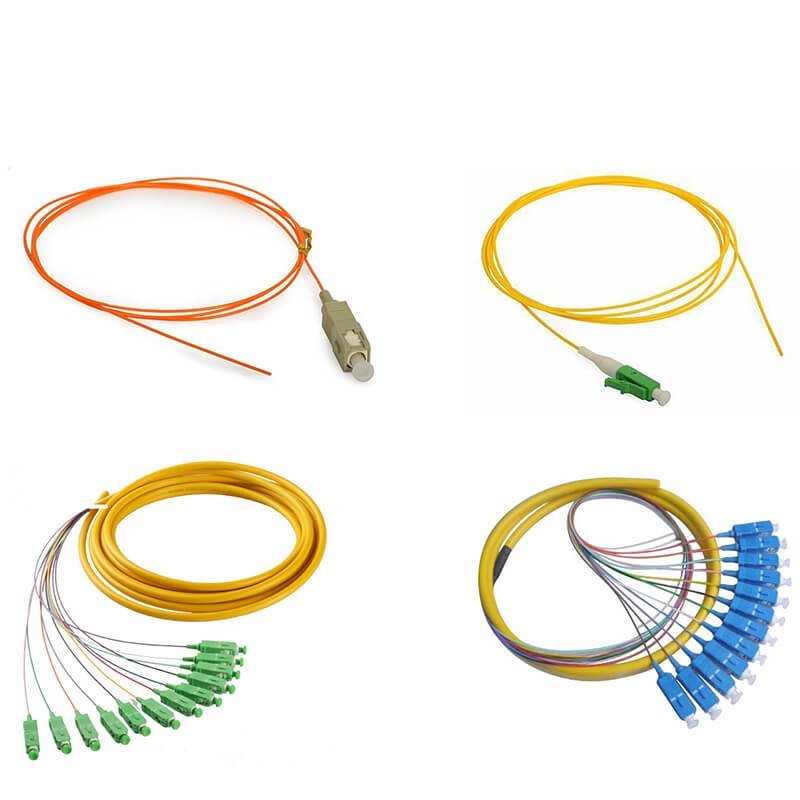Fiber Optic Pigtails
What is Fiber Optic Pigtails?
Fiber Optic Pigtails , In fiber optic cable installation, how cables are attached to the system is vital to the success of network. If done properly, optical signals would pass through the link with low attenuation and little return loss. pigtail offers an optimal way to joint optical fiber, which is used in 99% of single-mode applications. This post contains some basic knowledge of pigtail, including pigtail connector types, pigtail classifications, and pigtail splicing methods.
Pigtail are a fiber optic cable terminated with a factory-installed connector on one end, leaving the other end terminated. Hence the connector side can be linked to equipment and the other side melted with optical fiber cables.
pigtail has fiber connector installed at only one end, and the other end is left empty. While both ends of a fiber patch cord are terminated with fiber optic connectors.
Fiber Type
pigtails can be divided into single-mode (colored yellow) and multimode (colored orange) fiber. Multimode pigtails use 62.5/125 micron or 50/125 micron bulk multimode fiber cables and terminated them with multimode fiber optic connectors at one end. 10G multimode fiber cables (OM3 or OM4) are also available in optic pigtails. The jacket color of 10G OM3 and OM4 pigtail is usually aqua. Single-mode pigtail cables use 9/125 micron single-mode fiber cable and terminated with single-mode fiber connectors at one end.
Connector Type
According to different types of pigtail cable connector terminated at the end, there are LC fiber pigtail, SC pigtail, ST pigtail, FC pigtail, fiber pigtail and so on. With different structures and appearance, each of them has their own advantages in different applications and systems. Let’s go through some widely used ones.
SC Pigtail: SC pigtail cable connector is a non-optical disconnect connector with a 2.5mm pre-radiused zirconia or stainless alloy ferrule. SC pigtail is economical for use in applications such as CATV, LAN, WAN, test and measurement.
FC Pigtail: FC pigtail takes the advantage of the metallic body of FC optical connectors, featuring the screw type structure and high precision ceramic ferrules. FC pigtails and its related products are widely applied for the general applications.
ST Pigtail: ST pigtail connector is the most popular connector for multimode fiber optic LAN applications. It has a long 2.5mm diameter ferrule made of ceramic (zirconia), stainless alloy or plastic. Hence SC pigtails are commonly seen in telecommunications, industry, medical and sensor fields.
Like fiber optic patch cords,pigtail can be divided into UPC and APC versions. Most commonly used types are SC/APC pigtail, FC/APC pigtail and MU/UPC pigtail.
A pigtail is a single, short, usually tight-buffered, optical fiber that has an optical connector pre-installed on one end and a length of exposed fiber at the other end.
The end of the pigtail is stripped and fusion spliced to a single fiber of a multi-fiber trunk. Splicing of pigtails to each fiber in the trunk “breaks out” the multi-fiber cable into its component fibers for connection to the end equipment.
Pigtails can have female or male connectors. Female connectors could be mounted in a patch panel, often in pairs although single-fiber solutions exist, to allow them to be connected to endpoints or other fiber runs with patch fibers. Alternatively they can have male connectors and plug directly into an optical transceiver.Wiki


